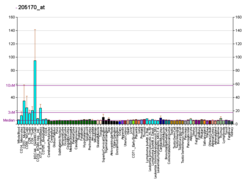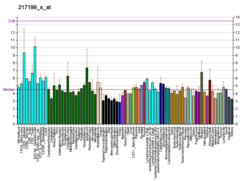| STAT2 |
|---|
|
| Available structures |
|---|
| PDB |
Ortholog search: PDBe RCSB
|
| List of PDB id codes |
|---|
2KA4 |
|
|
| Identifiers |
|---|
| Aliases |
STAT2, ISGF-3, P113, STAT113, IMD44, signal transducer and activator of transcription 2, PTORCH3 |
| External IDs |
OMIM: 600556 MGI: 103039 HomoloGene: 3952 GeneCards: STAT2 |
|
| Gene location (Mouse) |
|---|
 |
| Chr. |
Chromosome 10 (mouse) |
|
| Band |
10 D3|10 76.5 cM |
Start |
128,106,428 bp |
| End |
128,128,718 bp |
|
|
|
|
| Wikidata |
|
Signal transducer and activator of transcription 2 is a protein that in humans is encoded by the STAT2 gene. It is a member of the STAT protein family. This protein is critical to the biological response of type I interferons (IFNs). STAT2 sequence identity between mouse and human is only 68%.
Function
The protein encoded by this gene is a member of the STAT protein family. In response to cytokines and growth factors, STAT family members are phosphorylated by the receptor associated kinases, and then form homo- or heterodimers that translocate to the cell nucleus where they act as transcription activators. In response to IFN, this protein forms a complex with STAT1 and IFN regulatory factor family protein p48 (IRF9) and form ISGF-3 (IFN-stimulated gene factor-3), in which this protein acts as a transactivator, but lacks the ability to bind DNA directly. ISGF-3 proceeds the activation of genes via the IFN-stimulated response element (ISRE). ISRE-driven genes include Ly-6C, the double-stranded RNA kinase (PKR), 2´ to 5´ oligoadenylate synthase (OAS), MX and potentially MHC class I. Transcription adaptor P300/CBP (EP300/CREBBP) has been shown to interact specifically with this protein, which is thought to be involved in the process of blocking IFN-alpha response by adenovirus.
STAT2 knockout mice are unresponsive to type I IFN and extremely vulnerable to viral infection. They indicate the loss of the type I IFN autocrine loop and several defects in macrophages and T cell responses. Stat2-/- cells show differences in the biological response to IFN-α.
Interactions
STAT2 has been shown to interact with:
STAT2 deficiency
Knockout mice
In double knockout STAT2 mice, an increased proliferation of M1, M2, and M1/M2 coexpressing macrophages during influenza-bacterial super-infection is observed. The bacterial clearance was also impaired by neutralization of IFN-γ (M1) and Arginase-1 (M2) what suggests that pulmonary macrophages expressing a mixed M1/M2 phenotype promote bacterial control during influenza-bacterial super-infection. Therefore the STAT2 signaling is associated with suppressing macrophage activation and bacterial control during influenza-bacterial super-infection. These mice demonstrate no developmental defects. The knockout STAT2 and double knockout STAT mice in Vesicular stromatitis Indiana virus (VSV) model produce at least 10 times more virus plaque-forming units than the wild type (WT). IFN-α pretreatment supplied protection in WT and STAT2+/- cells but not in double knockout STAT2 cells. IFN-γ pretreatment did not provide any antiviral response during infection of VSV. This finding could be explained by the reduced level of STAT1 in cells of STAT2 knockout mice. Additionally, the double knockout STAT2 mice are more sensitive to mouse cytomegalovirus (MCMV), severe fever thrombocytopenia syndrome virus, influenza virus, dengue virus (DNV) and Zika virus than control mice, which suggests that STAT2 plays a critical role in the suppression of virus replication in mice.
Human autosomal recessive (AR) STAT2 deficiency
AR STAT2 deficiency was first time observed in 2 siblings. After routine immunization with measles-mump-rubella, one sibling developed disseminated vaccine-strain measles (MMR) but recovered and second sibling died in infancy from a viral infection due to primary immunodeficiency disorder. Later, the results showed that siblings were homozygous for absent expression of gene for STAT2. Patients with AR STAT2 deficiency have mutations which bring substitutions at important splice sites what leads to defected splicing and premature stop codons leading to a loss of expression of an interferon-stimulated gene. The typical clinical phenotype is disseminated infection after immunization with the live attenuated MMR vaccine. Some patients had also an onset of severe disease in infancy like infection with RSV, norovirus, coxsackievirus, adenovirus or enterovirus. One of the patients had CNS disease after the primary infection with EBV. EBV suppression was delayed in peripheral blood and cerebrospinal fluid as type I interferon signalling plays important role in the initial immune response against EBV. During next 3 years, PCR test showed persistent EBV presence in blood as well as in cerebrospinal fluid despite anti-EBV IgG. CMV and VZV infections were severe as well in few patients. The virus infection was treated by high-dose of intravenous immunoglobulin (IVIG) after which patients recovered and became afebrile within 24 hours. IVIG has anti-inflammatory effect and suggests that the passive immunization could help to control the ongoing viral infections. Therefore, the monthly IgG therapy could be beneficial for patients with STAT2 deficiency during childhood, until their adaptive immune system has sufficiently developed. From the age 5 years, the frequency and severity of viral infections decreased and the age of 10 years the patients were mostly off all medication. In general, the patients with STAT2 deficiency are relatively healthy with no specific defects in their adaptive immunity or developmental abnormalities. These findings show that type I IFN signaling trough ISGF3 is not essential for host defense against the majority of common childhood viral pathogens. Despite a profoundly defective innate IFN response and evident susceptibility to some viral infections, STAT2-deficient individuals can live a relatively healthy life. It was also reported a homozygous STAT2 missense mutation (R148W/Q) which results to a STAT2 gain of function underlying fatal early-onset autoinflammation in three patients. This mutation leads to a persistent type I IFN response due to defective binding of the mutated STAT2 to ubiquitin specific peptidase 1 (USP18) which is an essential in the negative autofeedback loop where USP18 sterically hinders the binding of JAK1 to IFNAR1. Therefore complete AR STAT2 deficiency usually causes disseminated LAV infection and recurrent natural viral infections. Penetrance is not complete for several viral infections and for complicated live measles vaccine disease. These observation suggest that the phenotype of AR STAT2 deficiency could range from asymptomatic (the healthy adult) to fatal (childhood death from a crushing viral disease). The phenotype is less severe than human complete AR STAT1 deficiency but more severe than IFNAR1 or IFNAR2 deficiency. The human phenotype is less severe than in mice.
Further reading
-
Cebulla CM, Miller DM, Sedmak DD (2000). "Viral inhibition of interferon signal transduction". Intervirology. 42 (5–6): 325–30. doi:10.1159/000053968. PMID 10702714. S2CID 22135982.
-
Kisseleva T, Bhattacharya S, Braunstein J, Schindler CW (February 2002). "Signaling through the JAK/STAT pathway, recent advances and future challenges". Gene. 285 (1–2): 1–24. doi:10.1016/S0378-1119(02)00398-0. PMID 12039028.
-
Fu XY, Schindler C, Improta T, Aebersold R, Darnell JE (August 1992). "The proteins of ISGF-3, the interferon alpha-induced transcriptional activator, define a gene family involved in signal transduction". Proceedings of the National Academy of Sciences of the United States of America. 89 (16): 7840–3. Bibcode:1992PNAS...89.7840F. doi:10.1073/pnas.89.16.7840. PMC 49807. PMID 1502204.
-
Uddin S, Chamdin A, Platanias LC (October 1995). "Interaction of the transcriptional activator Stat-2 with the type I interferon receptor". The Journal of Biological Chemistry. 270 (42): 24627–30. doi:10.1074/jbc.270.42.24627. PMID 7559568.
-
Marrero MB, Schieffer B, Paxton WG, Heerdt L, Berk BC, Delafontaine P, Bernstein KE (May 1995). "Direct stimulation of Jak/STAT pathway by the angiotensin II AT1 receptor". Nature. 375 (6528): 247–50. Bibcode:1995Natur.375..247M. doi:10.1038/375247a0. PMID 7746328. S2CID 4272223.
-
Sugiyama T, Nishio Y, Kishimoto T, Akira S (March 1996). "Identification of alternative splicing form of Stat2". FEBS Letters. 381 (3): 191–4. doi:10.1016/0014-5793(96)00121-4. PMID 8601453. S2CID 12860058.
-
Yan H, Krishnan K, Greenlund AC, Gupta S, Lim JT, Schreiber RD, et al. (March 1996). "Phosphorylated interferon-alpha receptor 1 subunit (IFNaR1) acts as a docking site for the latent form of the 113 kDa STAT2 protein". The EMBO Journal. 15 (5): 1064–74. doi:10.1002/j.1460-2075.1996.tb00444.x. PMC 450004. PMID 8605876.
-
Gupta S, Yan H, Wong LH, Ralph S, Krolewski J, Schindler C (March 1996). "The SH2 domains of Stat1 and Stat2 mediate multiple interactions in the transduction of IFN-alpha signals". The EMBO Journal. 15 (5): 1075–84. doi:10.1002/j.1460-2075.1996.tb00445.x. PMC 450005. PMID 8605877.
-
Li X, Leung S, Qureshi S, Darnell JE, Stark GR (March 1996). "Formation of STAT1-STAT2 heterodimers and their role in the activation of IRF-1 gene transcription by interferon-alpha". The Journal of Biological Chemistry. 271 (10): 5790–4. doi:10.1074/jbc.271.10.5790. PMID 8621447.
-
Bhattacharya S, Eckner R, Grossman S, Oldread E, Arany Z, D'Andrea A, Livingston DM (September 1996). "Cooperation of Stat2 and p300/CBP in signalling induced by interferon-alpha". Nature. 383 (6598): 344–7. Bibcode:1996Natur.383..344B. doi:10.1038/383344a0. PMID 8848048. S2CID 4306588.
-
Horvath CM, Stark GR, Kerr IM, Darnell JE (December 1996). "Interactions between STAT and non-STAT proteins in the interferon-stimulated gene factor 3 transcription complex". Molecular and Cellular Biology. 16 (12): 6957–64. doi:10.1128/mcb.16.12.6957. PMC 231699. PMID 8943351.
-
Bluyssen HA, Levy DE (February 1997). "Stat2 is a transcriptional activator that requires sequence-specific contacts provided by stat1 and p48 for stable interaction with DNA". The Journal of Biological Chemistry. 272 (7): 4600–5. doi:10.1074/jbc.272.7.4600. PMID 9020188.
-
Li X, Leung S, Kerr IM, Stark GR (April 1997). "Functional subdomains of STAT2 required for preassociation with the alpha interferon receptor and for signaling". Molecular and Cellular Biology. 17 (4): 2048–56. doi:10.1128/mcb.17.4.2048. PMC 232052. PMID 9121453.
-
Martinez-Moczygemba M, Gutch MJ, French DL, Reich NC (August 1997). "Distinct STAT structure promotes interaction of STAT2 with the p48 subunit of the interferon-alpha-stimulated transcription factor ISGF3". The Journal of Biological Chemistry. 272 (32): 20070–6. doi:10.1074/jbc.272.32.20070. PMID 9242679.
-
Mowen K, David M (November 1998). "Role of the STAT1-SH2 domain and STAT2 in the activation and nuclear translocation of STAT1". The Journal of Biological Chemistry. 273 (46): 30073–6. doi:10.1074/jbc.273.46.30073. PMID 9804758.
-
Dumler I, Kopmann A, Wagner K, Mayboroda OA, Jerke U, Dietz R, et al. (August 1999). "Urokinase induces activation and formation of Stat4 and Stat1-Stat2 complexes in human vascular smooth muscle cells". The Journal of Biological Chemistry. 274 (34): 24059–65. doi:10.1074/jbc.274.34.24059. PMID 10446176.
-
Paulson M, Pisharody S, Pan L, Guadagno S, Mui AL, Levy DE (September 1999). "Stat protein transactivation domains recruit p300/CBP through widely divergent sequences". The Journal of Biological Chemistry. 274 (36): 25343–9. doi:10.1074/jbc.274.36.25343. PMID 10464260.
-
Gupta S, Jiang M, Pernis AB (October 1999). "IFN-alpha activates Stat6 and leads to the formation of Stat2:Stat6 complexes in B cells". Journal of Immunology. 163 (7): 3834–41. doi:10.4049/jimmunol.163.7.3834. PMID 10490982. S2CID 255676952.
-
Vila-Coro AJ, Rodríguez-Frade JM, Martín De Ana A, Moreno-Ortíz MC, Martínez-A C, Mellado M (October 1999). "The chemokine SDF-1alpha triggers CXCR4 receptor dimerization and activates the JAK/STAT pathway". FASEB Journal. 13 (13): 1699–710. doi:10.1096/fasebj.13.13.1699. PMID 10506573. S2CID 13251398.
External links
This article incorporates text from the United States National Library of Medicine, which is in the public domain.
|
|
|---|
|
|
(2) Zinc finger DNA-binding domains |
|---|
|
(2.1) Nuclear receptor (Cys4)
|
|
| (2.2) Other Cys4 |
|
| (2.3) Cys2His2 |
|
| (2.4) Cys6 |
|
| (2.5) Alternating composition |
|
| (2.6) WRKY |
|
|
|
|
|
(4) β-Scaffold factors with minor groove contacts
|
|---|
|
|
|
(0) Other transcription factors |
|---|
|
|
|
|
|
|
|---|
| Chemokine |
|
| CSF |
|
| Interferon |
| IFNAR (α/β, I) |
-
Agonists: Albinterferon
- Interferon alpha (interferon alfa, IFN-α)
-
Interferon alfa (IFNA1, IFNA2, IFNA4, IFNA5, IFNA6, IFNA7, IFNA8, IFNA10, IFNA13, IFNA14, IFNA16, IFNA17, IFNA21)
- Interferon alfa 2a
- Interferon alfa 2b
- Interferon alfa n1
- Interferon alfacon-1
- Interferon alpha-n3
-
Interferon beta (IFN-β) (IFNB1, IFNB3)
- Interferon beta 1a
- Interferon beta 1b
- Interferon kappa (IFN-ε/κ/τ/ζ, IFNK)
- Interferon omega (IFN-ω, IFNW1)
- Peginterferon alfa-2a
- Peginterferon alfa-2b
|
| IFNGR (γ, II) |
|
| IFNLR (λ, III) |
- See IL-28R (IFNLR) here instead.
|
|
| Interleukin |
|
| TGFβ |
|
| TNF |
|
| Others |
|






